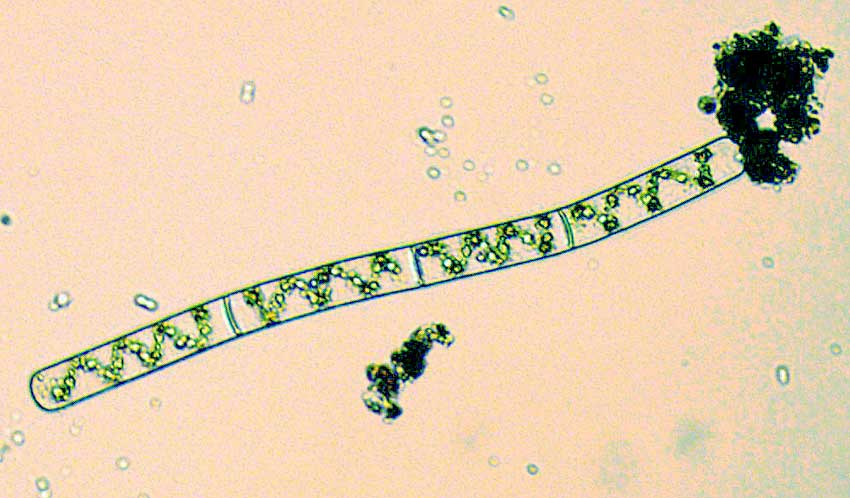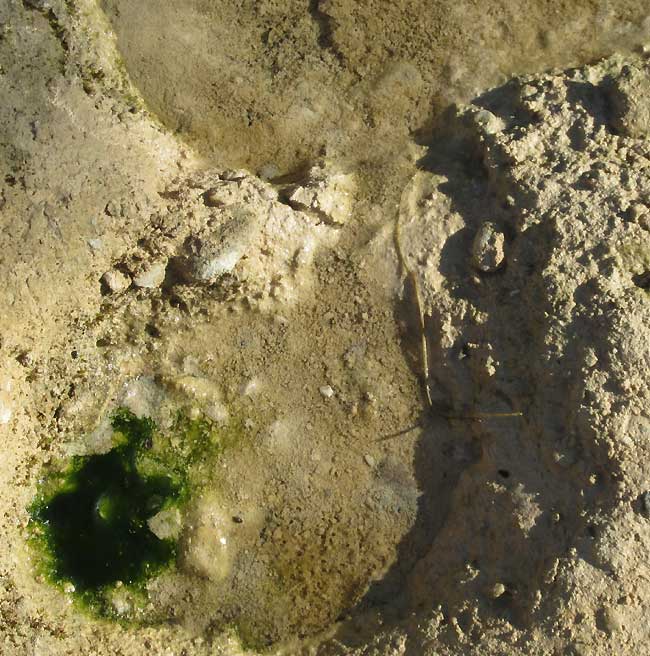Excerpts from Jim Conrad's
Naturalist Newsletter

from the October 21, 2012 Newsletter issued from the valley of the Dry Frio River in northern Uvalde County, southwestern Texas, on the southern border of the Edwards Plateau; elevation ~1750m (~5750 ft); N29.62°, W99.86°; USA
SPIROGYRA/ FROG SPITTLE
Immediately after gaining access to a microscope with a camera attachment, I hiked down to the little Dry Frio River behind the cabin, scooped some water with a little mud in it into a cup, brought it home and looked at it. It was like going to a zoo with lots of moving things I couldn't identify, but one that I could. You can see the thing I knew above.
That's the filamentous green alga known as Spirogyra. No algal genus is easier to identify microscopically than Spirogyra, because of the unique and beautiful helical or spiral arrangement of the chloroplasts. In the above picture each segment is a cell connected end-to-end with other cells. The black blob at the top, right is just debris. Again, the spiraling things are chloroplasts, which are cell bodies, or organelles, containing chlorophyll used for photosynthesis. Spiraling chloroplasts are very different from the spiraling DNA found in cell nuclei and visible only with very much higher magnification. In other algal cells chloroplasts may be scattered randomly or in other configurations. Many algal cells contain only one chloroplast.
Interestingly, chloroplasts have their own DNA. It's thought that that's because early during the evolution of Life on Earth a free-living cell such as an algal cell took into its body a similarly free-living cyanobacteria -- the bigger cell "ate" the smaller cyanobacteria cell -- but instead of the cyanobacteria being absorbed into the larger cell's body, the cyanobacteria survived and began sharing its photosynthesized products with its new "host cell," and ever since then the offspring of that first ingested cyanobacteria have lived as chloroplasts in algal and plant cells.
Anyway, what's in the photograph is an alga of the genus Spirogyra, of which more than 400 species have been recognized around the world. Species are identified largely on their conjugation pattern (sexual practices) and reproductive stages. I don't know what species is shown in the photograph but it looks like SPIROGYRA COMMUNIS, an exceptionally widespread (worldwide), common species.
Our little strand of Spirogyra was so small that I didn't see it when I placed a drop of water on the slide. In nature Spirogyra presents itself as very fine, bright, dark-green filaments moving gently with the water currents in the water. Masses of Spirogyra feel slimy, the slime deterring creatures which otherwise might attach themselves to it.
I had expected most pages on the Internet dealing with Spirogyra to be praising its beauty and ecological importance, but I should have guessed: Most deal with how to get rid of Spirogyra -- pages sponsored by dredging contractors, pond liner companies, fish stocking companies, etc. Spirogyra doesn't cause problems in low, natural concentrations but water with a heavy nutrient load, such as streams with fertilizer runoff or lots of phosphorus from urban-based detergents, can "bloom," clogging water filters and turning streams or aquaria into green soup.
You can see a variety of Spirogyra species at http://protist.i.hosei.ac.jp/pdb/Images/Chlorophyta/Spirogyra/.
issued September 4, 2020 from the valley of the Dry Frio River in northern Uvalde County, southwestern Texas, on the southern border of the Edwards Plateau; elevation ~1750m (~5750 ft); N29.62°, W99.86°; USA
MORE PICTURES
Along the muddy edge of the little Dry Frio River, especially where water seeps from underground, nowadays when the water level is low it's normal to see splotches of intense dark green, usually egg-size to saucer-size algae, as shown below:

A microscope is available here, and when strands of the dark green alga are highly magnified, you see what's shown below:

The above photo shows small, spherical items embedded in the spiraling chloroplast. Those are pyrenoids, which produce photosynthesized carbohydrate. You can also see the cell walls, and where the walls form partitions between the individual cells.